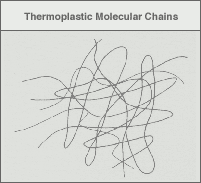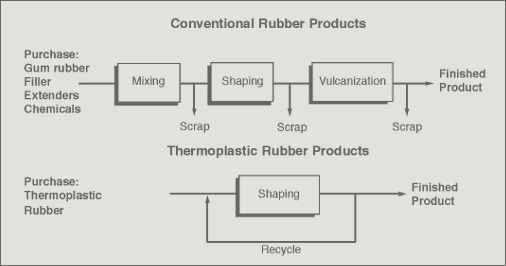Frequently Asked Questions about TPEs
1. What is a TPE?
Thermoplastic Elastomers are generally low modulus, flexible materials that can be stretched repeatedly to at least twice their original length at room temperature with an ability to return to their approximate original length when stress is released. The grandfather materials with this property are thermoset rubbers, but many families of injection-moldable thermoplastic elastomers (TPEs) are replacing traditional rubbers. In addition to use in their basic form, TPEs are widely used to modify the properties of rigid thermoplastics, usually improving impact strength. This is quite common for sheet goods and general molding TPEs.
Types of TPEs
Until as recently as 1996, the six primary TPE types could be categorized into two generic classes, block copolymers (styrenics, copolyesters, polyurethanes and polyamides) or thermoplastic/elastomer blends & alloys (thermoplastic polyolefins and thermoplastic vulcanizates).
In addition to these TPEs, two new technologies have emerged. They are the metallocene-catalyzed polyolefin plastomers & elastomers, and reactor-made thermoplastic polyolefin elastomers.
Traditional TPE types are known as two-phase systems. Essentially, a hard thermoplastic phase is coupled mechanically or chemically with a soft elastomer phase, resulting in a TPE that has the combined properties of the two phases.
Traditional TPE Classes
- Styrenics (S-TPE's)
- Copolyesters (COPE's)
- Polyurethanes (TPU's)
- Polyamides (PEBA's)
- Polyolefin Blends (TPO's)
- Polyolefin Alloys (TPV's)
New TPE Entrants
- Reactor TPO's (R-TPO's)
- Polyolefin Plastomers (POP's)
- Polyolefin Elastomers (POE's)
The new POPs and POEs are essentially very low molecular weight, linear low density polyethylenes (VLMW-LLDPE). The results of advancements in polymerization catalyst technology, these materials were originally developed to improve flexible packaging film characteristics. Recently, these more flexible polyethylenes have seen use as low-cost rubber replacements for some non-demanding molded goods applications. These primarily include products that will not be exposed to extremes in temperatures, pressures, loads or stress environments. In molded goods, these new materials are being used where a more or less limited degree of flexibility or tactile feel is desired. Note that they are not true elastomers.
2. What kind of stretch properties can I expect from my TPE?
Tensile Properties
Tensile properties are measurements used to describe how an elastomer performs when stretched. Several tests are commonly used to give an indication of how a TPE will perform in end-use environments.
Tensile at Break
This measurement is also called Ultimate Tensile. In this test, a piece of elastomer is stretched until it breaks. The amount of force needed to break the material is measured. Units are typically given in pounds per square inch (psi) or megaPascals (MPa). Elastomers with high ultimate tensile properties will be more difficult to break by stretching than an elastomer with lower values on this test.
Tear Strength
This value describes how well the elastomer resists tearing. The tear strength test essentially the same as the tensile at break test except the test bar is notched on one side to provide a propagation point. The material is stretched and the amount of force at which the test bar tears completely is recorded. Units are typically given in psi or kiloNewtons per meter (kN/m).
Tensile Modulus
In the tensile modulus test, the elastomer is stretched and resistance to the stretching is measured over a range of elongation points. This is often reported as tensile at various percentages of the original length of elastomer, such as 50, 100 and 300 percent. An elastomer might have a strong resistance to stretching initially but become weaker as it elongates (called "necking").
Elongation at Break
Elongation does not measure how hard or easy the material is to stretch, but simply how far it will stretch before it breaks. This is reported in percentage of original length. Some soft elastomers will stretch to greater than 1000 percent of their original length before breaking. A soft elastomeric TPE will typically have a much higher value than a hard rigid material.
Factors Affecting Values
The method in which test plaques are molded and the direction of flow affect the tensile property values. For this reason, many elastomers are measured for tensile properties in both direction of flow and transverse to direction of flow.
Direction of Flow
Like many other elastomer properties, tensile properties are affected by the orientation of the polymer molecules upon molding. Thus tensile properties can vary widely depending on whether the stretching was done in the direction of the polymer flow during molding, or in the transverse direction.
Test Plaques (Extrusion vs. Injection Molded)
Some tests are performed on injection molded plaques, while others are performed on extruded plaques. It is important to compare values only on similar test plaque types since there can be a significant difference in values.
3. How does “compression set” apply to TPEs?
Compression set is the amount of permanent deformation that occurs when a material is compressed to a specific deformation, for a specified time, at a specific temperature.
The usual ASTM test method used (ASTM D395) calls for the material to be 25 percent deformed (compressed) for a given period. After a 30-minute recovery time, the sample is measured.
- 23° C (Room temperature)
22 hrs, 70 hrs, 168 hrs (1 week), 1000 hrs (42 days) - 70° C
22 hrs, 70 hrs, 168 hrs (1 week), 1000 hrs (42 days) - 121° C
22 hrs, 70 hrs, 168 hrs (1 week), 1000 hrs (42 days) - 150° C
22 hrs, 70 hrs, 168 hrs (1 week), 1000 hrs (42 days)
The value derived is the percent a material sample that fails to recover to its original height. For example a compression set of 40 percent states that the thermoplastic elastomer regained only 60 percent of its compressed thickness. A compression set of 100 percent says that the thermoplastic elastomer never recovers - it remains compressed.
Often creep is confused with compression set. However, compression set is the amount of deformation under a constant strain, whereas creep is the amount of deformation under a constant stress.
4. Is there a service temperature for TPEs?
The term Service Temperature is loosely used to define the maximum temperature at which a material is suited for use.
Service Temperature is dependent upon many factors, including performance requirements, length of exposure, and presence of a load and part design.
Some common methods of measuring service temperature are Vicat Softening Temperature, Heat Deflection Temperature (HDT), Underwriter's Laboratory (UL), Half Tensile Strength and other proprietary methods depending on the industry.
Example applications requiring relatively high service temperatures include automotive/transportation, hydraulic hoses and mining cables. Examples of applications that do not require high service temperature include general indoor applications such as grips on personal care products and kitchenware, telephone cords and toys.
5. What is meant by hardness?
Hardness
The relative softness or hardness of a material is often one of the first criteria considered when choosing a thermoplastic elastomer. Hardness is also related to other important design properties, such as tensile and flexural modulus. Confusion can arise when discussing hardness due to the variety of measurement scales and its relationship to other material properties.
Measurement of hardness
The most common instrument for measuring rubber hardness is called a Shore durometer. A spring is used to push a metal indenter into the surface of the material, measuring how far it penetrates. The instrument measures the depth penetration from zero to 0.100 inches. A zero reading on the scale means the indenter is at the maximum depth and a reading of 100 indicates that no penetration was detected.
Shore durometers come in a variety of hardness ranges. One of the most common scales is the Shore A scale, using a blunt indenter and a moderate spring force. Shore A instruments are not as accurate when readings are above 90. For harder materials, the Shore D durometer is used, as it has a sharp indenter and a stronger spring to penetrate to a greater depth.
When even harder plastics are measured, instruments with sharper indenters and stronger forces such as Rockwell hardness testers are used. At the other end of the scale, soft gels and soft foam rubbers are measured using the Shore 00 scale.
Most materials will resist initial indenting but will yield further over time due to creep or relaxation. Durometer readings can either be taken instantaneously or after a specific delay time, which typically ranges between 5 and 10 seconds. An instantaneous reading will always give a higher (or harder) reading than the delayed readings. Delayed readings are more representative of not only the hardness of the material but the resiliency. A weak, less elastomeric material will creep more than a higher strength, more resilient material.
Accurate testing procedures are needed to ensure valid data. To get an accurate reading you must have a flat part surface, as well as sufficient part thickness to prevent the support surface from affecting the result. The usual required thickness is 0.200 inches, but hard TPEs that experience less deformation can be accurately measured at lower thicknesses.
Relationship to other properties
Hardness is often confused with other properties such as flexural modulus. Although both properties reflect how the product feels in the customer's hands, flexural modulus measures the resistance to bending, while hardness measures the resistance to indentation. Within a specific TPE family, these two properties are related. Generally as hardness goes up in value, so does flexural modulus.
Creep resistance and tensile strength in a given TPE family are generally directly related. This means a softer TPE will creep more and have less tensile strength than a harder material. The coefficient of friction (COF) varies inversely with hardness. As the hardness of a TPE increases the COF generally decreases.
When comparing TPEs across different families, actual physical property data beyond hardness is required to make appropriate material decisions.
6. Definitions of regulatory terms
Food and Drug Administration (FDA)
Under the code of Federal Regulations, Title 21, Chapter 1, Subchapter B, the US Food and Drug Administration provides detailed specifications regarding the requirements for acceptance of various polymers and TPEs for intended use in food applications. When a product is classified as an "FDA grade" material, it designates that only 21 CFR, parts 170-199 approved materials are used in its formulation.
National Sanitation Foundation (NSF)
The National Sanitation Foundation is known for the development of standards, product testing and certification services in the areas of public health safety and protection of the environment. NSF certification programs are accredited by the American National Standards Institute (ANSI/RAB), The Dutch Council for Accreditation (RvA) and the Standards Council of Canada (SCC).
Testing alliances allow for NSF testing acceptance in other regions of the world as well. Some of the alliances include Intertek Testing Services (ITS), KIWA N.V. in The Netherlands, Canadian Standards Association (CSA) and QMI in Canada, and the Japan Gas Appliance Inspection Association (JIA) in Japan, to name a few.
Typical applications requiring NSF certification are potable water applications, water treatment systems, restaurant services and plumbing.
United States Pharmacopeia (USP)
USP specifications cover blood and body fluid compatibility/contact applications. USP tests are designed to provide information on biological effects of polymer materials used in containers. There are six classes into which a polymer may be placed, depending on its performance in specific USP biological tests. Each increasing class number, from I to IV, requires that a polymer be subjected to additional tests, with each level using more extraction vehicles than the previous class. There is also a range of increasingly higher extraction temperatures which may be selected to further characterize the material.
Underwriters Laboratories (UL)
Underwriters Laboratories is an independent, not-for-profit product safety and testing certification organization based in the US. Common tests are UL-94 (vertical and horizontal burn test further categorized under HB, V0, V1, or V2), VTM (thin film burn test) and VW (vertical wire burn test). Typical applications covered by UL specifications include hand-held electronics, business machines and appliances.
Military Specifications (MIL)
Certain US military and non-military applications may require military specifications. Such specifications include areas such as fungal growth, dimensional stability and many other material properties. In the TPE world, applications requiring military specs include umbilical cables, field-use flexible cords, underground cable and ship-to-shore cable.
Canadian Standards Association (CSA)
CSA is the principle Canadian standards body that sets performance criteria and test methods in certain applications. This is a body similar to that of ASTM, UL, DOT, FDA and MIL in the United States.
7. What is the difference between a thermoplastic versus a thermoset elastomer?
Elastomers are commonly grouped into two major categories:
- Thermoplastic
- Thermoset
Structure
Thermoplastic Elastomers are materials that repeatedly soften/melt when heated and harden when cooled. Most thermoplastics are soluble in specific solvents and can burn to some degree. Softening/melt temperatures vary with polymer type and grade. Because of the heat/shear sensitivity of thermoplastics, care must be taken to avoid degrading, decomposing or igniting the material.

Most thermoplastic molecular chains can be thought of as independent, intertwined strings resembling spaghetti (see the figure above). When heated (for example, for molding), the individual chains slip, causing plastic flow. When cooled, the chains of atoms and molecules are once again held firmly. When subsequently heated, the chains slip again. There are practical limitations to the number of heating/ cooling cycles to which thermoplastics can be subjected before appearance and mechanical properties are affected.
Thermoset Elastomers undergo a chemical change during processing to become permanently insoluble and infusible. It is this chemical cross-linking that is the principal difference between thermoset and thermoplastic systems. Natural and synthetic rubbers such as latex, nitrile, millable polyurethane, silicone, butyl and neoprene, which attain their properties through a process known as vulcanization, are typical thermoset elastomers.
As can be seen by the diagram below, when thermosets are cured or hardened, cross-links are formed between adjacent molecules, resulting in a complex, interconnected network. These cross bonds prevent the individual chains from slipping, thus preventing plastic flow when heat is added. If excessive heat is added to the thermoset elastomer after the cross-linking is complete, the polymer is degraded rather than melted. This behavior is somewhat similar to an egg when it is cooked: further heating does not return the egg to its liquid state, it only burns.

How to define processing
The capability to repeatedly process thermoplastic elastomers provides the major benefit of TPEs over thermoset rubbers. Other key processing differences are captured in the diagrams below.
|
Variable |
TPE |
Thermoset Rubber |
|---|---|---|
|
Fabrication |
Rapid (seconds) |
Slow (minutes) |
|
Scrap |
Reusable |
High Percentage waste |
|
Curing Agents |
None |
Required |
|
Machinery |
Conventional Thermoplastic Equipment |
Special Vulcanizing Equipment |
|
Additives |
Minimal or None |
Numerous Processing Aids |
|
Design Optimization |
Unlimited |
Limited |
|
Remold Parts |
Yes |
Unlikely |
|
Heat Seal |
Yes |
No |
Source: Robert Eller Associates

8. What are the benefits of TPEs compared to thermoset rubbers?
- Design flexibility
- Lower fabrication costs
- Shorter processing times
- Scrap is fully recyclable
- Consistency of product
- Can be blow molded
- Can be thermoformed
- Lower consumption of energy
- Simpler processing
- Better control of product quality
- Broader range in product density
- Lower per-piece finished part cost
- More environmentally friendly
9. How does shrinkage affect TPEs?
Shrinkage
As TPEs cool from their molten state, the molecules align with each other and shrink the overall size of the molded part. While usually only in the thousandths of an inch per inch range, shrinkage can dramatically affect the molding and removal of the part as well as the appearance of the final part.
If shrinkage is uneven, a part meant to lay flat can bend or warp. Additionally, in applications with tight tolerances, unexpected shrinkage may affect the fit of a part in an assembly.
For these reasons, shrinkage generally must be taken into account in production.
Part Removal
When parts contain cores or cut-outs, as the elastomer shrinks it can tighten around the tooling, making removal difficult. Mold design, mold surface finish and processing conditions can lessen this effect, and make even automatic removal possible.
Molding Conditions
Molding conditions can dramatically affect the amount and nature of shrinkage. Going quickly from a state of high stress to one of low stress can increase the amount of shrinkage. Quick cooling of a part as well as very high injection speeds or pressures can also affect shrinkage.
Design Considerations
Due to shrinkage, a mold must be cut larger than the desired size of the part. Generally, exact shrinkage values cannot be known until a specific part is molded, so it is always best to be conservative and use a prototype mold if at all possible.
As with other elastomer properties, shrinkage often varies with the direction of polymer flow. Gate location will determine the direction of flow into the part and thus the shrinkage direction. Also, some TPEs are more isotropic than others, meaning that they shrink more in one direction than another. This must be taken into consideration when designing the mold. Consult your TPE supplier for more information on how design considerations affect shrinkage.

